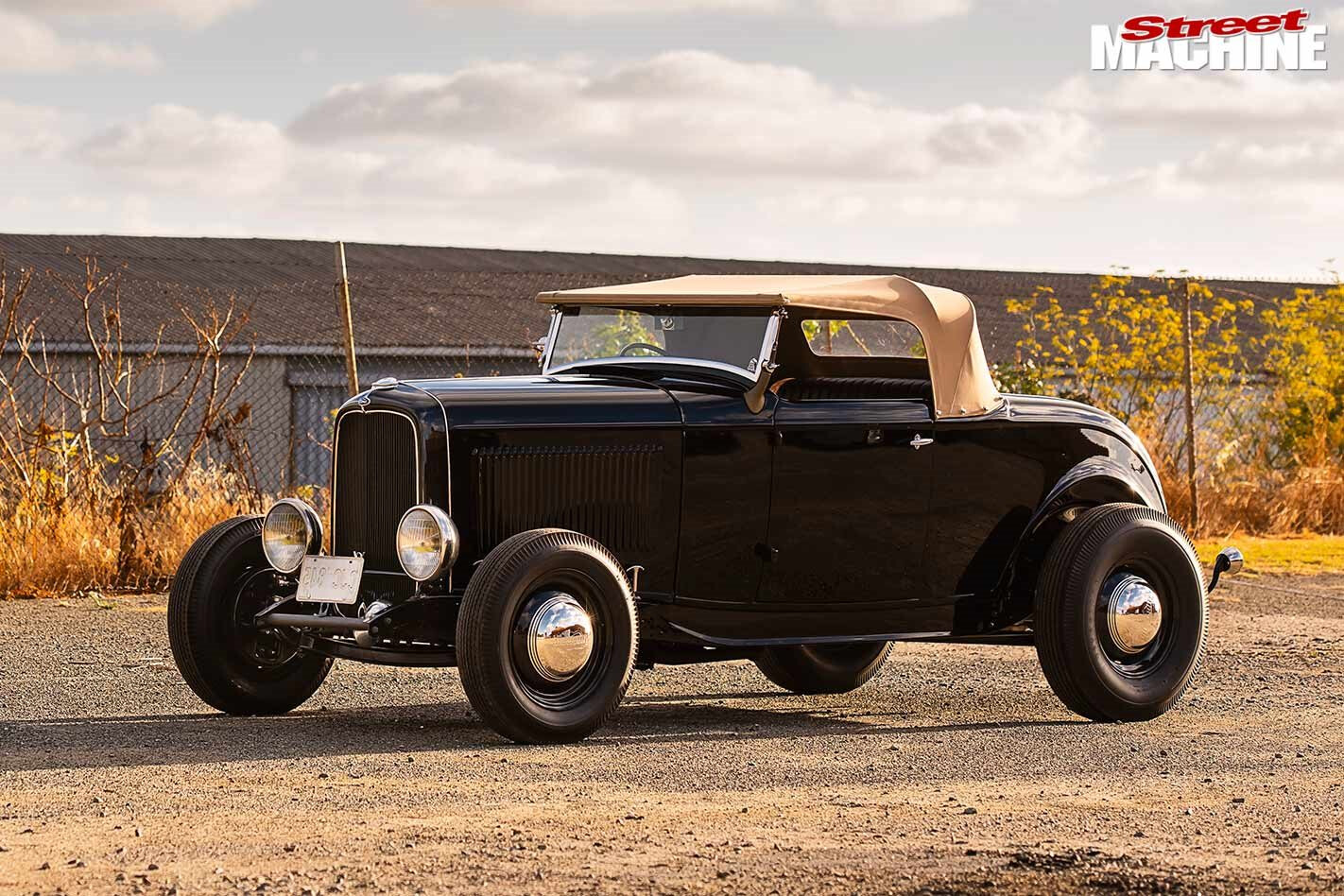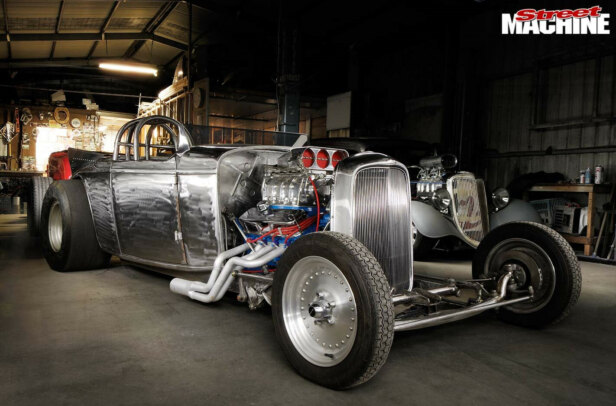NOTHING beats the old-timey character of a traditional hot rod. The low rumble of an early valve-in-head combustion engine; the intrinsic smell of rubber and oil; the unmistakable feel of aged leather; the tell-tale tread-marks of skinny Firestones on gravel roadways; the low, yellowed beams of aged headlamps. Tommy Sharman’s gorgeous ’32 Ford roadster has all this in spades.
This article was first published in Street Machine’s Hot Rod magazine #20, 2019
A beautifully executed hopped-up jalopy, the ’32 sports a chrome windscreen surround and pillars, a working cowl vent, and a solitary roof-mounted peep mirror. Further forward, ’32 headlights sit on a modified bar, which Tommy shortened and mounted from the chassis. ’40 Ford rims with Merc caps succinctly round off the look
“My family is into restoring and building traditional cars and bikes,” he says. “So I’ve always liked the traditional side of things and I’d always wanted a ’32 – it was an itch I wanted to scratch.”
Tommy loves the build process; he enjoys the challenge of combining parts that weren’t designed to work together and getting them to play nicely with each another. But, unbelievably, this is his first hot rod project.
Model A-style tail-lights flank the tucked ’32 rear, while the shiny peek-a-boo Halibrand quick-change draws your eye beneath for further inspection. Symmetrical exhaust pipes skim the surface of the glossy fuel tank, neatly finishing what is often an under-prepared area
“While I always wanted a ’32, I had to wait, because they’re expensive. It all takes money, time and research of finding the styles I like,” he says.
While Tommy spent time homing in on his preferred look, he also slowly collected parts of the era that piqued his interest. A sensible way to go about it, especially as the build took off much faster than he had initially expected.
“I was at my friend Les Moran’s place and saw this beautiful 8BA that he and Mark Gamble had built,” he explains. “I thought I’d buy it and put it to one side for when I eventually build the hot rod. But then I started getting into it straight away.”
Tommy was the main spanner guy, welder, panel-beater and pretty much everything else during the project. Underneath, he opted for an original 1932 right-hand-drive chassis, which he sourced locally, then proceeded to disassemble, repair, then re-rivet in the crossmembers while making required tweaks along the way. On top, he opted for new rather than waiting years to source old tin.
“I debated using an A-Model body, but that’s not what I truly wanted, so I paid the extra for a ’32,” Tommy explains of the Brookville Roadster repro body. His mate, Magic Mike at Ramcharger Painting Services, neatly coated the fresh steel in gloss black – Henry Ford’s favourite.
Up front, that beautiful Evans-headed 8BA sits on the original ’32 front crossmember and retains the factory engine mounts. None of it was easy to put together though.
“When one wheel was raised, the crank pulley fouled with the cross steering, so I modified the pulley and the lower water outlets, then used different radiator hoses. There’s just so many of those little changes and details,” Tommy says.
Those neat headers were Tommy-built too, using 1-3/4in bends, down to a twin system through a pair of small, round mufflers that just happened to look the part.
Tommy’s first hot rod project wasn’t without its hiccups. “Early on I bought a bunch of repro parts from the USA and I quickly realised that they were junk, so I binned them and rebuilt the original stuff,” he says. “Those businesses went through the effort of recreating those parts, so you’d think that they would think about the quality.”
This stunning sidevalve Ford was the catalyst for the build and features rare Evans-scripted heads and Thickstun manifold. Tommy’s dad, Bruce Sharman from Bygone Spares & Restoration, added the finishing touch of full cloth-braided wiring. “As the fuel pump was deleted from the 8BA, and I didn’t want a modern electric unit, Dad suggested an SU double-ended pump from a Jag or Rolls-Royce, which I’ve tucked under the chassis rails out of sight,” says Tommy
In keeping with his preference for early parts, Tommy used RotoFlo dampeners. Once he freed them up, he reckons they now work quite well. Up the back are ’42 Ford radius rods attached to a tasty Halibrand centre running ’40 Ford tubes, axles and drums. An A-Model spring and replica Houdaille shock absorbers finish things off and allow a great view of that pretty quick-change rear.
The minimalistic theme continues inside, with a tuck-and-roll trimmed bench in tan aged leather complemented by timber flooring and a handful of gauges. A ’39 Ford banjo wheel steers via a ’34 Ford box chosen for its preferred ratio. Above, Tommy modified the roof bows so that the roof sits a little better
The beautifully executed cabin most certainly has the visual cues of a postwar-era creation. “It’s minimalistic and classy,” Tommy says. Another mate, Kiwi Stu, is the artist responsible for swathing Tommy’s hand-made seat frame and door cards in aged leather, before trimming the roof in a weather-appropriate cloth. Below, the timber floors were also laid by Tommy. You might notice that the dash has been tweaked too.
“I added the centre portion of an original ’32 dash so that it looked old,” Tommy says. “They’re also original ’32 gauges that were still working when I bought them; I just added water temp and oil light for running it in.”
Thanks to a mixture of solid research, good mates and sheer hard work and determination, the ’32 was a driving reality only 12 months later.
“I just drive it around, take my kid to school and drive it to work. I just use it; it’s something cool. I built what I wanted.”
And we’re chuffed that Tommy did just that.
TOMMY SHARMAN
1932 FORD ROADSTER
Paint: Gloss Black
ENGINE
Brand: Ford sidevalve 8BA
Capacity: 276ci
Carbs: Dual Stromberg 97
Manifold: Thickstun
Heads: Evans
Springs: Isky
Valves: Chev 1.6in
Camshaft: Waggott full-race
Conrods: Stock, shot-peened
Pistons: Ross
Crank: Mercury 4-1/8in stroked
Oil pump: Melling high-volume
Fuel system: SU double-ended pump
Cooling: Walker radiator
Exhaust: 1-3/4in home-built
Ignition: Joe Hunt
DRIVELINE
Gearbox: ’39 Ford with Lincoln-Zephyr gears
Clutch: 10in
Tailshaft: ’34 Ford modified
Diff: Halibrand quick-change centre, ’40 Ford tubes and axles
SUSPENSION & BRAKES
Front: Stock ’32 heavy axles, unsplit wishbones, ’32 spring with reversed eyes, RotoFlo dampeners
Rear: Replica Houdaille shock absorbers, Model A spring, unsplit ’42 bones
Steering: ’34 Ford box, ’39 Ford banjo steering wheel
Brakes: ’40 ford drums (f & r)
Master cylinder: Dual
WHEELS & TYRES
Rims: 1940 Ford; 16×4.5 (f), 16×6.5 (r)
Rubber: Firestone; 550/16 (f), 700/16 (r)
THANKS
Les Moran for the advice, help, parts and late-night phone calls; ‘John Boy’ Ridell for all of the help throughout the build; Magic Mike for all of the paint; Stu for the trim; Bruce Sharman for the full cotton-braided wiring harness; Anthony at Aeroplate for all of the bead-blasting; Phil Pav for all of the hard-to-get bits; my girl Tash and my son Detroit for putting up with the late nights and weekends of work




Comments